Coyotes Conquered North America. Now They’re Heading South.

Most landowners and wildlife managers think that killing coyotes is a good practice. They are mistaken – to put it mildly – that coyote ‘control’ is even possible. The more coyotes we kill, the faster coyotes breed. Biologists say we would need to kill 75% of all coyotes every year for 50-years to achieve even a momentary regional population reduction. Stated differently, so-called coyote eradication turns out to be coyote expansion. After 100-years, there are more coyotes alive today than when eradication began. Today, coyotes are found everywhere on the continent – including our cities – whereas before government-funded wolf and predator eradication, coyotes were only in our deserts.
But the bigger issue is the whole bundle of practices that we follow in wildlife ‘management’. It is incorrect that coyote ‘control’ helps wildlife and habitat. Coyotes are beneficial in many ways, including to quail. Landowners should look into holistic management and be very skeptical of most wildlife ‘management’ practices because so many waste money and harm wildlife over long terms.
NOTE: this article below is from NYTimes.com. It was written by JoAnna Klein and published May 24, 2018
New maps seek to update the historical range of our continent’s toughest canids, which have thrived as other predators experienced decline.
Coyotes are excellent colonizers.
They breed fast, eat almost anything and live just about anywhere. You can find them in fields, forests, backyards, parks and even parking decks. They’re living in cities like Los Angeles, New York and Chicago. They’ve even made it to the Florida Keys and Long Island. In 2010, they crossed the Panama Canal. Now, the only thing keeping them from entering Colombia is a dense patch of forest called the Darien Gap. And camera traps have caught them heading that way.
“I don’t think anyone’s betting against the coyote getting to South America eventually,” said Roland Kays, an ecologist at North Carolina State University and the North Carolina Museum of Natural Sciences. “They have to be one of the most adaptable animals on the planet.”
To understand how these wily wanderers roamed so far, Dr. Kays and James Hody, a graduate student, sifted through thousands of museum specimens, fossil records, peer-reviewed reports and records from wildlife agencies and traced the animals’ paths back 10,000 years. Their resulting maps, published Tuesday in ZooKeys, show how wrong we’ve been about the historical range of our continent’s toughest canids. The maps also provide a foundation for scientists to start asking questions about what happens when new predators enter a habitat, and how hybridization influenced coyote evolution.
From at least 10,000 years ago, coyotes lived in grasslands, prairies and deserts, as far east as the Mississippi and Ohio rivers and as far west as California. But after 1900, coyotes started moving out, in all directions, into forested habitats. By the 1920s, they had made their way into Alaska, and by the 1990s, to the East Coast. Even with wildlife managers working to get rid of coyotes, the animals have managed to expand their range since 1950 by at least twice that of any other North American carnivore during the same time.
They thrived, in part, because of increasing forest fragmentation and agricultural lands along with the annihilation of predators like wolves, cougars and jaguars. And because some coyotes once mated with wolves or dogs, resulting hybrids developed traits to help them adapt in new environments. Dr. Kays thinks wolf genes that made some coyotes bigger (but not a separate, “fear-mongering hype” species some call a coywolf, he points out) likely allowed them to expand more rapidly into the Northeast. It’s unclear what the dog genes have done for coyotes — other than making some look more German shepherd-like.
There are other mysteries. For example — how did coyotes expand so rapidly into Alaska and the Northwest, where forests are still relatively intact and full of wolves and mountain lions?

Coyotes are not the only ones positioned to swap continents. South America’s crab-eating fox is now in Panama too and headed north. If coyotes make it to South America, this will be the first time the continents have exchanged predators in three million years. There’s no telling what will happen.
Still another question remains.
“Is this something we should view as a natural expansion, that’s a good thing, or that we should view as an invasive species, that’s a bad thing?” asks Dr. Kays. “In some ways that’s a philosophical question, because in the end, there’s nothing we can do about it.”
